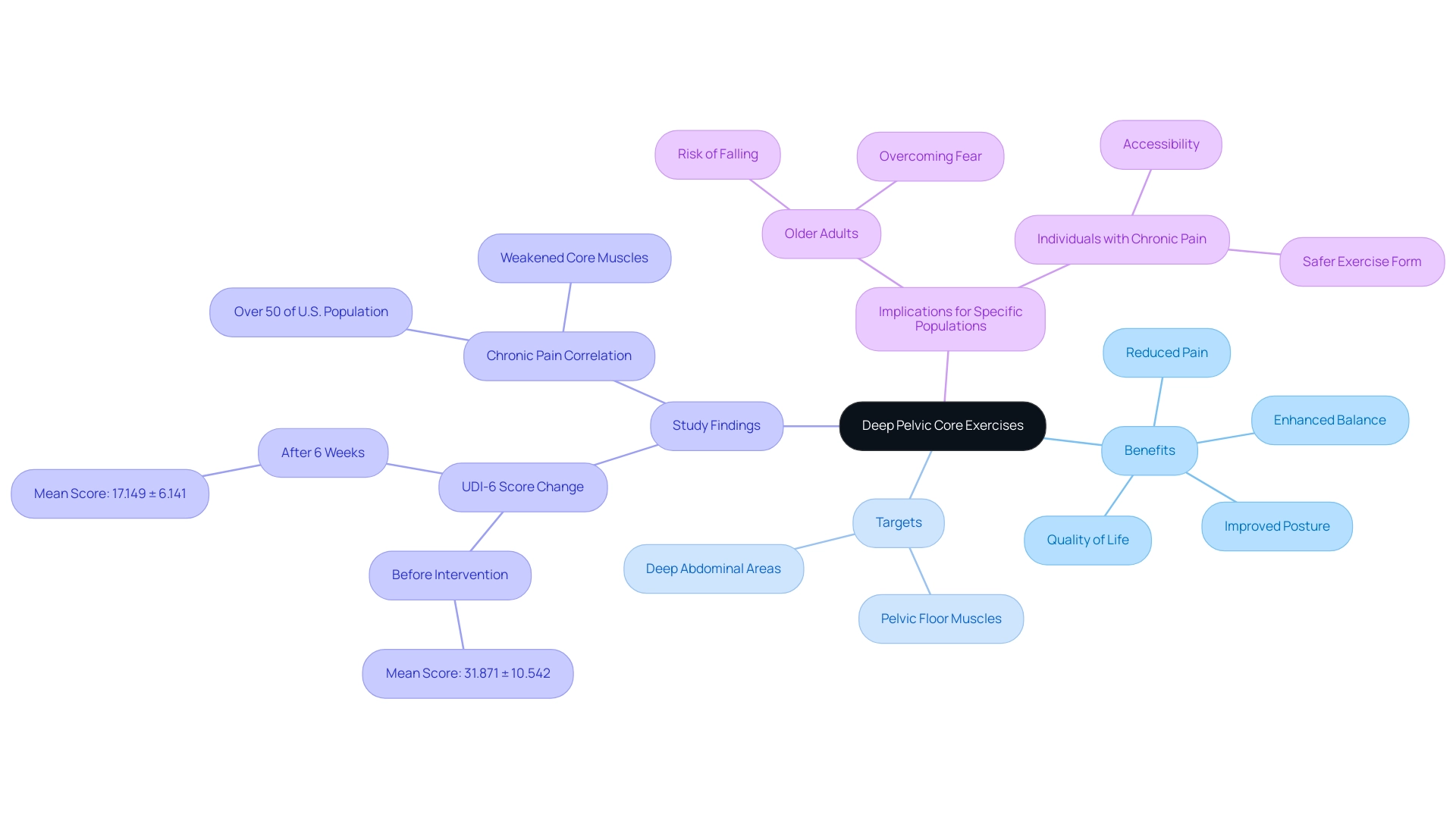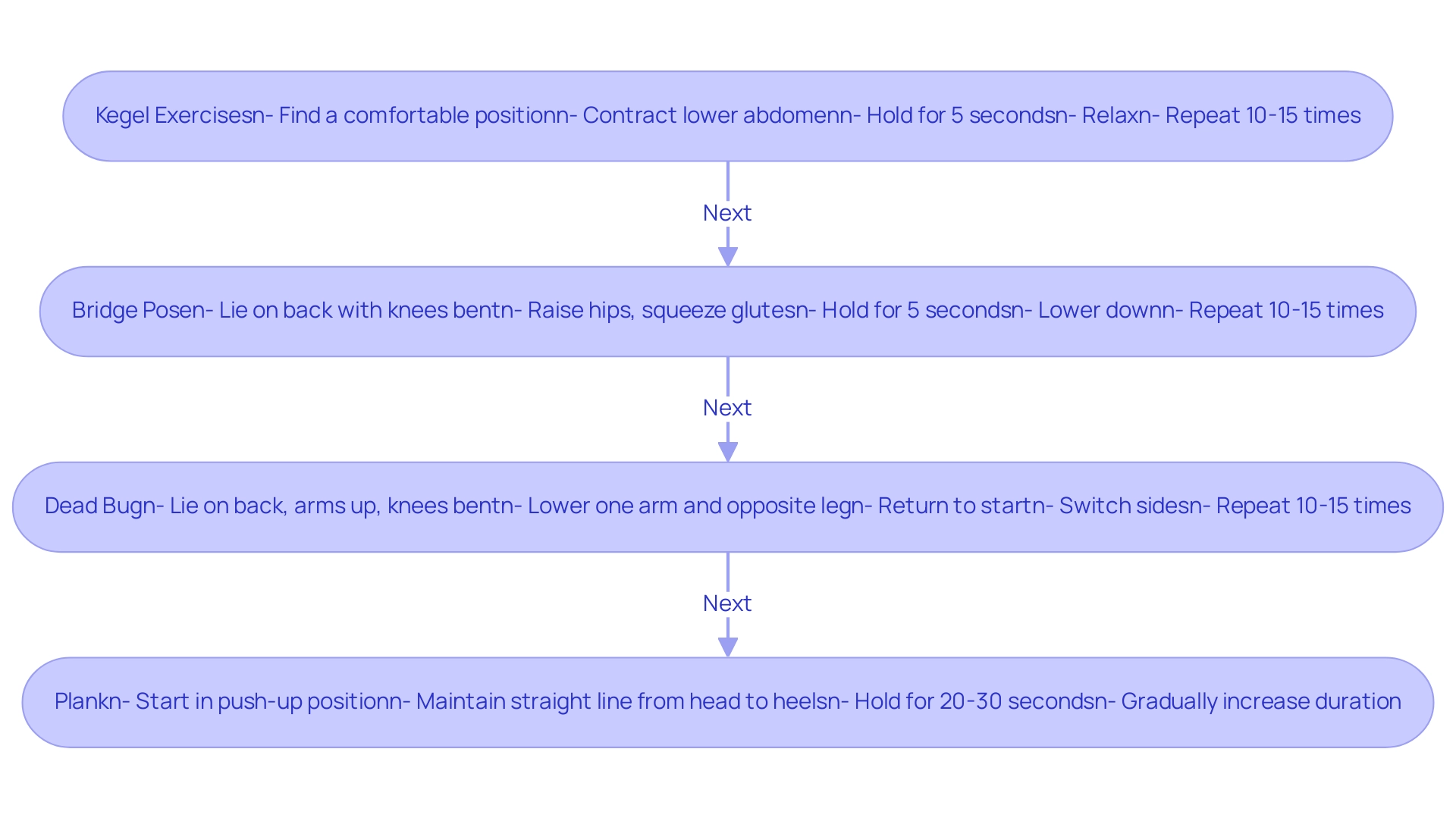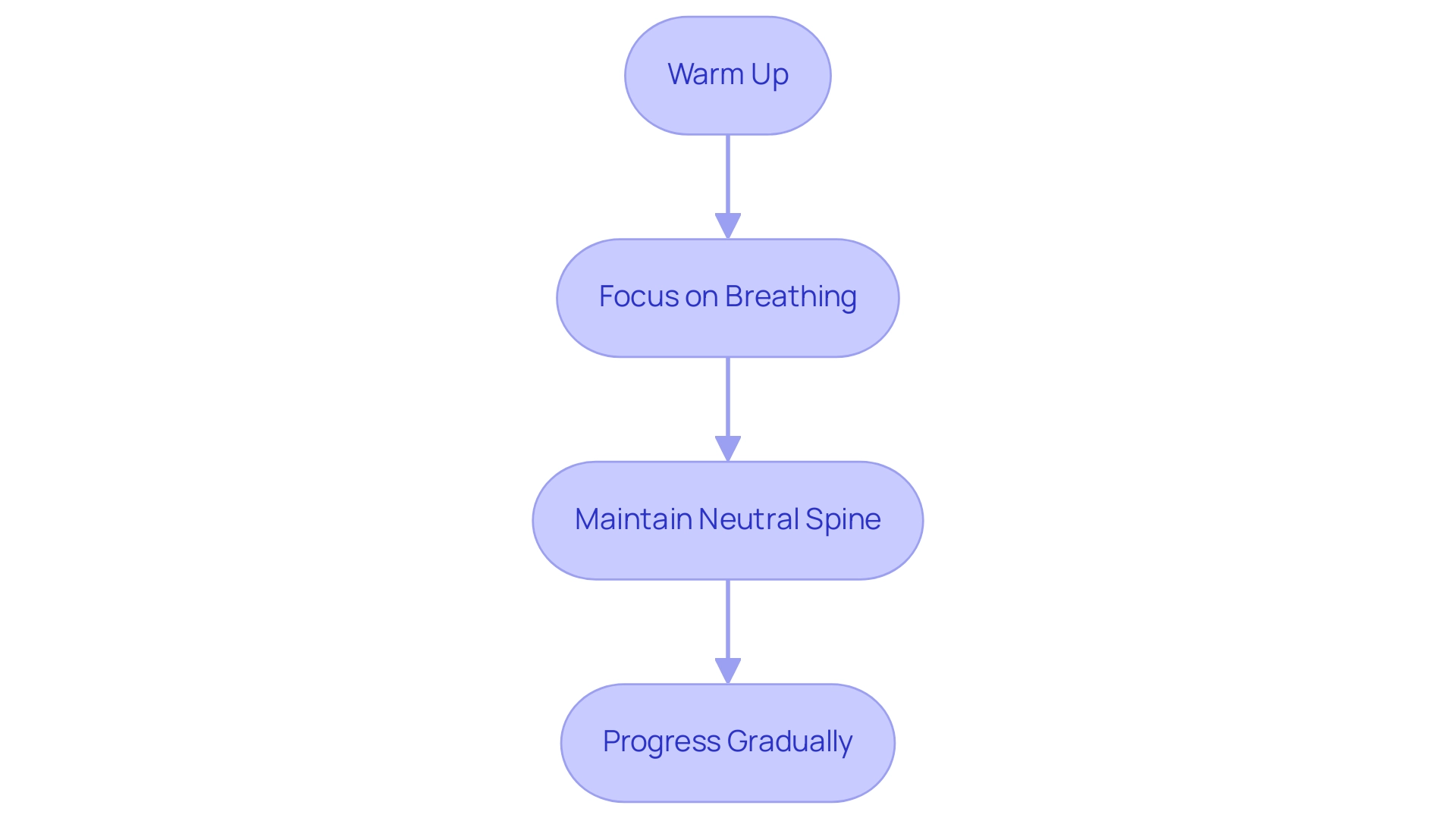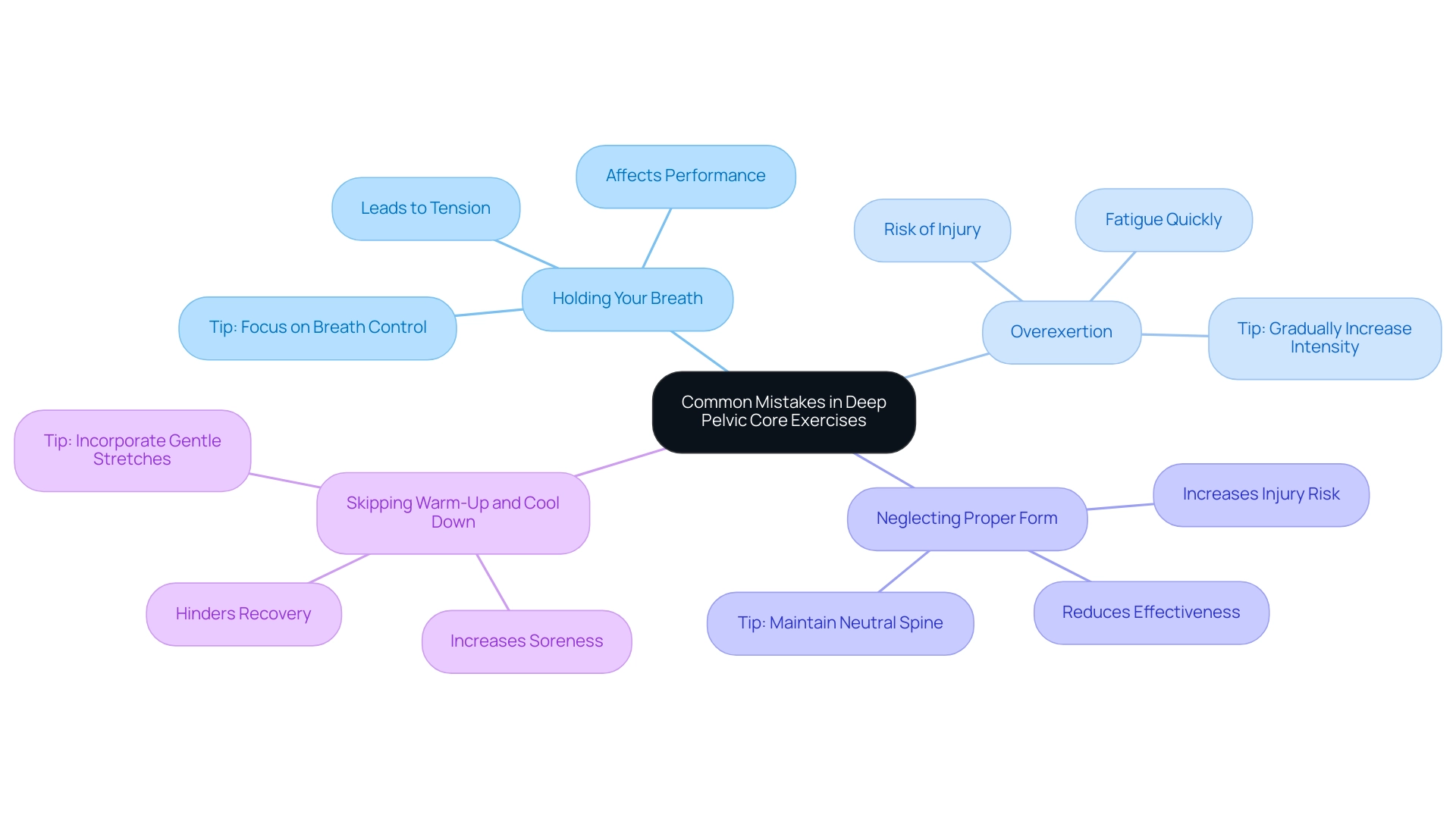Overview
Deep pelvic core exercises are crucial for enhancing core stability, improving posture, and reducing the risk of injuries, as they target the pelvic floor and deep abdominal muscles. The article emphasizes that these exercises not only alleviate common issues like lower back pain and incontinence but also significantly boost overall physical performance and quality of life, supported by studies showing marked improvements in well-being after consistent practice.
Introduction
Strengthening the deep pelvic core is more than just a fitness trend; it’s a transformative journey that can significantly enhance overall well-being and productivity. As individuals engage in specific exercises targeting the pelvic floor and deep abdominal muscles, they not only cultivate a stable core but also pave the way for improved posture, balance, and resilience against injuries. The benefits extend beyond physical health, influencing mental clarity and workplace motivation, making it essential for teams to prioritize these practices.
With compelling evidence linking core strength to reduced back pain and enhanced performance, embracing a routine of deep pelvic core exercises can empower individuals to tackle daily challenges with renewed confidence and vigor. This article delves into the importance of these exercises, outlines effective techniques, and highlights the broader impact on both personal health and workplace dynamics.
Understanding Deep Pelvic Core Exercises: Importance and Benefits
Deep pelvic core exercises are essential for cultivating a robust and stable core that underpins overall body function. These targeted workouts include deep pelvic core exercises that engage the pelvic floor and deep abdominal areas, leading to notable improvements in posture, balance, and a significantly reduced risk of injury. Importantly, strengthening these muscle groups can alleviate common challenges such as lower back pain and incontinence, ultimately enhancing physical performance and overall quality of life.
Recent studies indicate that individuals who adopt these routines experience a marked improvement in their well-being, with the mean UDI-6 score reflecting a change from 31.871 ± 10.542 to 17.149 ± 6.141 after just six weeks of intervention. This highlights the powerful impact deep pelvic exercises can have on daily functionality. Furthermore, fundamental training is particularly beneficial for older adults at risk of falling, helping them overcome fear and related issues.
A case study titled 'Central Strength and Chronic Pain' revealed that over 50% of people in the U.S. live with chronic back pain, highlighting the correlation between weakened central muscles and pain intensity. This case study supports the idea that strength training is a safer and more accessible form of physical activity for individuals with back pain compared to resistance training. By integrating these practices into your routine, not only do you foster a healthier and more resilient body, but you also empower yourself to tackle daily activities with greater ease and optimize your work performance.
As John Doe aptly noted, while the sample size of the related studies may be limited, the findings clearly point to the transformative potential of deep pelvic core exercises, particularly for those grappling with chronic pain. It is also important to note that the exclusion criteria for the studies included the absence of an objective pain scale and specific diagnosed pathology contributing to non-specific lower back pain (NSLBP), which may affect the generalizability of the results. Make the commitment to elevate your core strength—your body will thank you for it.

Key Exercises for Strengthening the Pelvic Floor and Core
- Kegel Exercises: Begin by finding a comfortable position that allows you to focus. Contract your lower abdominal area as if you’re attempting to halt the flow of urine. Hold this contraction for 5 seconds, then relax. Aim to repeat this 10 to 15 times. Regular practice of deep pelvic core exercises under specialist supervision can significantly improve your outcomes, ensuring you are on the right path to strengthening this vital area. In fact, a study by La Pera (1996) discovered that 61% of patients attained satisfactory control of their ejaculatory reflex after finishing a series of pelvic floor training sessions, emphasizing the effectiveness of these activities. With our health coaching app, you can access guided Kegel exercises as part of your daily programming, ensuring consistency and support from your coach.
- Bridge Pose: Lie flat on your back with your knees bent and feet firmly on the floor. As you raise your hips towards the ceiling, squeeze your glutes and activate your abdominal muscles. Hold this position for 5 seconds, then lower back down. Repeat for 10 to 15 repetitions. This pose not only boosts lower body strength but also enhances overall abdominal stability and mobility. The app includes video demonstrations to help you master this pose, integrating it into your comprehensive wellness program.
- Dead Bug: Position yourself on your back with your arms extended towards the ceiling and your knees bent at a 90-degree angle. Slowly lower one arm and the opposite leg towards the floor, ensuring your back remains flat against the surface. Return to the starting position and switch sides. Perform this activity 10 to 15 times. This movement is excellent for coordination and trunk strength, which can be enhanced through deep pelvic core exercises that directly benefit the pelvic region. Our app offers movement flows that include this activity for a comprehensive workout experience, making it easy to stay on track with your health goals.
- Plank: Start in a push-up position, ensuring that your body forms a straight line from head to heels. Engage your center and maintain this position for 20 to 30 seconds. As your strength increases, gradually extend the duration of your hold. Plank movements are crucial in developing deep pelvic core exercises, which support the lower abdomen and enhance overall stability. Monitor your progress using the app for extra motivation, as these activities are part of a structured program aimed at assisting you in reaching your wellness goals.
Additionally, a study titled 'Correlation Between PFMS and ISI' revealed no significant correlation between changes in pelvic floor strength and incontinence severity, indicating that while strength improves, it does not always directly relate to reductions in incontinence severity. As you begin these activities, remember that if you encounter difficulties, seeking guidance from a physical therapist can provide invaluable support. The app’s direct messaging feature allows you to connect with your coach for personalized assistance and encouragement.
Prioritizing these workouts not only empowers your personal fitness journey but also bolsters your team's well-being, fostering a healthier, more productive workplace through the app's comprehensive resources.

Techniques for Safe and Effective Deep Core Workouts
To ensure safe and effective workouts for deep core muscles, it's vital to implement the following techniques:
- Warm Up: Begin every session with a warm-up lasting around 15 minutes to prepare your muscles for the workout ahead. Engaging in light cardio or dynamic stretches can significantly enhance your performance. Research indicates that a well-structured warm-up is crucial for optimizing exercise effectiveness. As noted by McGowan et al., this practice is widely embraced in sports settings because athletes believe warm-ups are essential for achieving peak performance. Furthermore, a study titled "Effects of an Integrative Warm-Up Method" demonstrated that a structured warm-up positively impacts the strength of stabilizer trunk muscles and the quality of basic movement patterns, particularly in adolescents.
- Focus on Breathing: Proper breathing is key to abdominal engagement. Inhale deeply through your nose, allowing your abdomen to expand fully. Exhale slowly through your mouth while consciously activating your abdominal muscles. This technique enhances muscle activation and promotes stability during deep pelvic core exercises.
- Maintain Neutral Spine: Keep your spine in a neutral position throughout your workouts to prevent injury. Avoid overarching or rounding your back, as this can lead to strain and discomfort. Maintaining proper alignment is essential for effective trunk training.
- Progress Gradually: Begin with manageable variations of fundamental movements and slowly enhance the intensity as your strength improves. Pay attention to your body's signals; if you experience pain, don’t hesitate to rest or modify your workout. This approach fosters a sustainable fitness routine that prioritizes safety and effectiveness.
By adopting these techniques, you can create a supportive environment that encourages safe and impactful workouts, ultimately benefiting your team's overall well-being.

Common Mistakes to Avoid in Deep Pelvic Core Exercises
To truly maximize the benefits of deep pelvic core exercises, it's crucial to avoid these common pitfalls:
- Holding Your Breath: A frequent mistake among exercises is the tendency to hold their breath, which can lead to unnecessary tension and diminish the effectiveness of the workout. In fact, DeGennaro et al. (2017) reported a mean maximal intra-abdominal pressure of 124 CMH during jumping jacks, highlighting the importance of breath control for optimal performance. Focusing on your breath not only enhances performance but also supports physical engagement.
- Overexertion: It's tempting to push your limits, but overdoing it can result in injury. Begin with manageable repetitions, and as your strength builds, gradually increase the intensity. As a case study suggests, deep pelvic core exercises are essential for pelvic floor muscles to engage adequately to fatigue for effective strengthening, and beginners may tire quickly. Remember, progress is a journey, not a race.
- Neglecting Proper Form: Maintaining proper form is essential for reaping the full benefits of your workouts and reducing the risk of injury. Always strive for a neutral spine and proper alignment throughout your movements. As Ingrid Elisabeth Nygaard from the University of Utah School of Medicine highlights, "the right technique is vital for effective strengthening."
- Skipping Warm-Up and Cool Down: Never underestimate the power of a good warm-up and cool-down. These practices are essential for preparing your body for exercise and aiding recovery afterward. Incorporate gentle stretches and mobility work to set yourself up for success and mitigate soreness post-workout.
By steering clear of these mistakes, you can enhance your workout effectiveness, promote safety, and foster a healthier lifestyle for yourself and your team.

The Broader Impact of Strengthening Your Pelvic Floor and Core
Engaging in deep pelvic core exercises to enhance your pelvic floor and abdominal muscles can unlock a multitude of benefits that extend beyond mere physical improvements, significantly impacting workplace performance and motivation. Consider the following advantages:
- Improved Posture: A robust core plays a crucial role in maintaining proper alignment, effectively reducing strain on both the back and neck. This is essential in a world where increased computer use has been linked to greater head, neck, and thorax flexion during prolonged sitting. As Leon Straker observed, 'Growing computer usage was associated with enhanced head, neck, and thorax flexion during typical sitting,' emphasizing the necessity for abdominal strength to mitigate these effects.
- Enhanced Stability and Balance: By fortifying these foundational muscles, you can significantly boost your overall stability, thereby decreasing the likelihood of falls and injuries. This is particularly vital in both workplace and athletic environments, contributing to a safer and more productive workforce.
- Reduced Back Pain: Performing deep pelvic core exercises can strengthen the pelvic floor and abdominal muscles, alleviating pressure on the spine and leading to noticeable reductions in back pain. A strong center serves as a supportive framework for the spine, enhancing comfort and mobility, which is essential for maintaining high levels of employee motivation and engagement.
- Better Athletic Performance: Whether you are a weekend warrior or a seasoned athlete, a strong center is instrumental in enhancing performance across various physical activities. A systematic review titled Central Training and Performance confirms that central training significantly amplifies performance metrics in athletes, which can translate into improved energy and focus at work.
- Increased Confidence: As your strength builds and your body awareness improves, many individuals experience a surge in self-esteem and confidence. This newfound assurance can positively influence all aspects of life, from personal interactions to professional engagements, fostering a motivated and emotionally healthy workplace.
Investing in core and floor strength not only promotes physical well-being but also fosters a culture of health and resilience within your organization. Empower your team to embrace these practices, inspired by studies that show regular exercise leads to higher motivation and lower stress levels, and watch as their overall performance and confidence flourish. Notably, a study published in the Journal of Occupational Health Psychology found that employees who exercised regularly reported feeling positive emotions at work, such as happiness and satisfaction, while also experiencing lower levels of negative emotions like anger and anxiety.
Additionally, Kegel's 1948 study provides a historical context, affirming the long-recognized importance of deep pelvic core exercises for improved posture and overall health, which aligns with contemporary findings on workplace motivation.

Conclusion
Strengthening the deep pelvic core is a vital investment in both personal health and workplace productivity. Engaging in targeted exercises, such as:
- Kegels
- Bridge poses
- Planks
not only cultivates a robust core but also enhances posture, balance, and resilience against injuries. The substantial evidence presented underscores how these practices can alleviate common issues like lower back pain, ultimately empowering individuals to navigate daily challenges with greater ease and confidence.
Moreover, the importance of proper techniques, such as warm-ups and breath control, cannot be overstated. Avoiding common mistakes like overexertion and neglecting form will ensure that workouts are both safe and effective. By fostering a culture that prioritizes core strength, organizations can enhance overall employee well-being, leading to improved motivation, reduced stress, and a more engaged workforce.
Ultimately, the benefits of strengthening the pelvic floor and core extend far beyond physical fitness. They contribute to a healthier, more resilient team that is better equipped to tackle challenges, both in and out of the workplace. Encouraging these practices is not just a wellness initiative; it is a pathway to a more productive and harmonious work environment. Now is the time to take action and embrace the transformative power of deep pelvic core exercises for the benefit of individuals and teams alike.
Frequently Asked Questions
What are deep pelvic core exercises?
Deep pelvic core exercises are targeted workouts designed to engage the pelvic floor and deep abdominal areas, contributing to improved posture, balance, and reduced risk of injury.
What benefits do deep pelvic core exercises provide?
These exercises can alleviate common issues like lower back pain and incontinence, enhance physical performance, and improve overall quality of life.
How effective are deep pelvic core exercises according to recent studies?
Recent studies show significant improvements in well-being, with participants experiencing a reduction in the mean UDI-6 score from 31.871 to 17.149 after six weeks of intervention.
Who can particularly benefit from deep pelvic core exercises?
Older adults at risk of falling can greatly benefit, as these exercises help them overcome fear and related issues.
What does the case study 'Central Strength and Chronic Pain' reveal?
The case study indicates that over 50% of people in the U.S. live with chronic back pain, linking weakened central muscles to increased pain intensity and suggesting that strength training is a safer option for these individuals.
What is the significance of the studies mentioned regarding deep pelvic core exercises?
While the sample sizes may be limited, the findings suggest that deep pelvic core exercises have transformative potential, especially for those with chronic pain.
What are some examples of deep pelvic core exercises?
Examples include Kegel exercises, Bridge Pose, Dead Bug, and Plank, each focusing on different aspects of core strength and stability.
How can individuals practice these exercises effectively?
Regular practice under specialist supervision is recommended to ensure proper technique and maximize outcomes.
What should individuals do if they face difficulties with these exercises?
Seeking guidance from a physical therapist can provide valuable support and assistance.
How can technology aid in performing these exercises?
Health coaching apps can offer guided exercises, video demonstrations, and direct messaging features to connect with coaches for personalized support.

